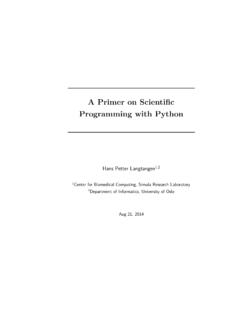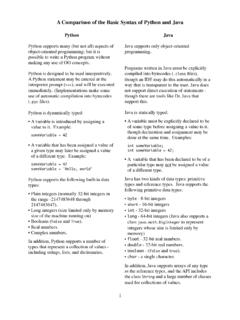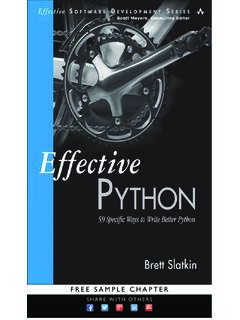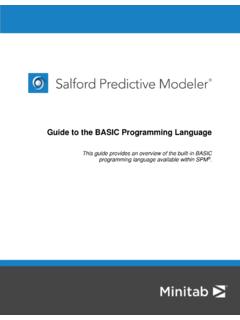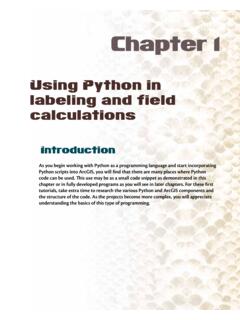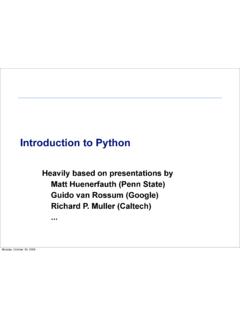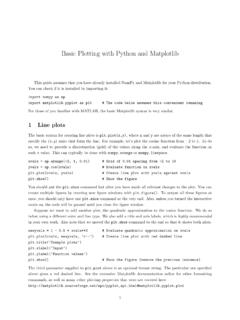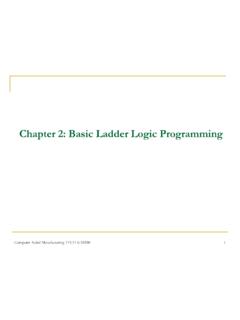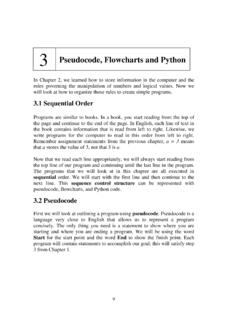Transcription of Basic Python by examples - LTAM
1 LTAM-FELJC 1 Basic Python by installationOn Linux systems, Python is already download Python for Windows and OSx, and for documentation see might be a good idea to install the Enthought distribution Canopy that contains already the very useful modules Numpy, Scipy and Matplotlib: or Python ?The current version is libraries may not yet be available for version 3, and Linux Ubuntu comes with as a standard. Many approvements from 3 have been back ported to main differences for Basic programming are in the print and input will use Python in this interactive: using Python as a calculatorStart Python (or IDLE, the Python IDE).
2 A prompt is showing up:>>>Display version:>>>help()Welcome to Python ! This is the online help > Help commands:modules: available moduleskeywords: list of reserved Python keywordsquit:leave helpTo get help on a keyword, just enter it's name in 2 Simple calculations in Python >>> * operators:OperatorExampleExplication+, - *, /add, substract, multiply, divide%modulo25 % 5 = 084 % 5 = 425/5 = 5, remainder = 084/5 = 16, remainder = 4**exponent2**10 = 1024//floor division84//5 = 1684/5 = 16, remainder = 4 Take care in Python if you divide two numbers:Isn't this strange:>>> 35/65 Obviously the result is wrong! But:>>> >>> 35 the first example , 35 and 6 are interpreted as integer numbers, so integer division is used and the result is an uncanny behavior has been abolished in Python 3, where 35/6 gives Python , use floating point numbers (like , ) to force floating point division!
3 Another workaround would be to import the Python 3 like division at the beginning:>>> from __future__ import division >>> 3/4 Builtin functions:>>> hex(1024)'0x400'>>> bin(1024)'0b10000000000'Expressions:>>> ( +4)/64>>> (2+3)*525 LTAM-FELJC 3 variablesTo simplify calculations, values can be stored in variables, and and these can be used as in normal mathematics.>>> a= >>> b = >>> a+b >>> a-b >>> a**2 + b**2 >>> a>b False The name of a variable must not be a Python keyword!Keywords are: and elif if print as else import raise assert except in return break exec is try class finally lambda while continue for not with def from or yield del global pass functionsMathematical functions like square root, sine, cosine and constants like pi etc.
4 Are available in Python . To use them it is necessary to import them from the math module:>>> from math import * >>> sqrt(2) :There is more than one way to import functions from modules. Our simple method imports all functions available in the math module. For more details see examples using math:Calculate the perimeter of a circle>>> from math import * >>> diameter = 5 >>> perimeter = 2 * pi * diameter >>> Calculate the amplitude of a sine wave:>>> from math import * >>> Ueff = 230>>> amplitude = Ueff * sqrt(2)>>> 4 scripts (programs)If you have to do more than a small calculation, it is better to write a script (a program in Python ).
5 This can be done in IDLE, the Python good choice is also Geany, a small freeware editor with syntax colouring, from which you can directly start your write and run a program in IDLE: Menu File New Window Write script File Save (name with extension .py, for example ) Run program: <F5> or Menu Run Run ModuleTake care: In Python white spaces are important!The indentation of a source code is important! A program that is not correctly indented shows either errors or does not what you want! Python is case sensitive!For example x and X are two different variables. simple programThis small program calculates the area of a circle:from math import *d = # diameterA = pi * d**2 / 4print "diameter =", dprint "area = ", ANote: everything behind a "#" is a are important for others to understand what the program does (and for yourself if you look at your program a long time after you wrote it).
6 InputIn the above program the diameter is hard coded in the the program is started from IDLE or an editor like Geany, this is not really a problem, as it is easy to edit the value if a bigger program this method is not very little program in Python asks the user for his name and greets him:s = raw_input("What is your name?")print "HELLO ", sWhat is your name?TomHELLO TomLTAM-FELJC 5 Take care:The raw_input function gives back a string, that means a list of characters. If the input will be used as a number, it must be and objectsIn Python , values are stored in objects. If we dod = a new object d is created. As we have given it a floating point value ( ) the object is of type floating point.
7 If we had defined d = 10, d would have been an integer other programming languages, values are stored in variables. This is not exactly the same as an object, as an object has "methods", that means functions that belong to the our beginning examples the difference is not are many object types in most important to begin with are:Object typeType class nameDescriptionExampleIntegerint Signed integer, 32 bita = 5 FloatfloatDouble precision floating point number, 64 bitb = numberc = 3 + 5jc= complex(3,5)CharacterchrSingle byte character d = chr(65)d = 'A'd = "A"Stringstr List of characters, text stringe = 'LTAM'e = "LTAM" with data conversionIf we use the raw_input function in Python or the input function in Python 3, the result is always a string. So if we want to input a number, we have to convert from string to = int(raw_input("Input an integer: "))y = float(raw_input("Input a float: "))print x, yNow we can modify our program to calculate the area of a circle, so we can input the diameter:""" Calculate area of a circle"""from math import *d = float(raw_input("Diameter: "))A = pi * d**2 / 4print "Area = ", ADiameter: 25 Area = LTAM-FELJC 6 Note:The text at the beginning of the program is a description of what it does.
8 It is a special comment enclosed in triple quote marks that can spread over several program should have a short description of what it loopsWe can use the computer to do tedious tasks, like calculating the square roots of all integers between 0 and 100. In this case we use a while loop:""" Calculate quare root of numbers 0 to 100"""from math import *i = 0while i<= 100: print i, "\t\t" , sqrt(i) i = i + 1print "READY!"0 1 2 3 ..98 99 100 READY! The syntax is :while <condition> :<..block of >The block of statements is executed as long as <condition> is True, in our example as long as i <= care: Don't forget the ":" at the end of the while statement Don't forget to indent the block that should be executed inside the while loop!The indentation can be any number of spaces ( 4 are standard ), but it must be consistent for the whole endless loops!
9 In the following example the loop runs infinitely, as the condition is always true:i = 0while i<= 5 : print iLTAM-FELJC 7 The only way to stop it is by pressing <Ctrl> of conditions:Examplex == 3 True if x = 3x != 5 True if x is not equal to 5x < 5x > 5x <= 5x >= 5 Note:i = i +1 can be written in a shorter and more "Pythonic" way as i += conditions: if, elif, else Sometimes it is necessary to test a condition and to do different things, depending on the : avoiding division by zero, branching in a menu structure following program greets the user with "Hello Tom", if the name he inputs is Tom:s = raw_input ("Input your name: ")if s == "Tom": print "HELLO ", sNote the indentation and the ":" behind the if statement!
10 The above program can be extended to do something if the testing condition is not true:s = raw_input ("Input your name: ")if s == "Tom": print "Hello ", selse: print "Hello unknown" It is possible to test more than one condition using the elif statement:s = raw_input ("Input your name: ")if s == "Tom": print "Hello ", selif s == "Carmen": print "I'm so glad to see you ", selif s == "Sonia": print "I didn't expect you ",s else: print "Hello unknown" Note the indentation and the ":" behind the if, elif and else statements!LTAM-FELJC 8 Python , variables can be grouped together under one name. There are different ways to do this, and one is to use make sense for small collections of data, for coordinates:(x,y) = (5, 3)coordinates = (x,y)print coordinatesdimensions = (8, , )print dimensionsprint dimensions[0]print dimensions[1]print dimensions[2](5, 3) (8, , ) 8 Note:The brackets may be omitted, so it doesn't matter if you write x, y or (x, y) (arrays)Lists are ordered sequences of can for example be very practical to put many measured values, or names of an address book, into a list, so they can be accessed by one common name.
